Sri Pada—Buddhism's Most Sacred Mountain
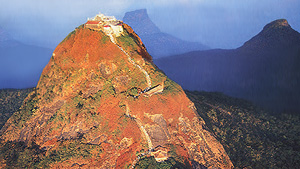
|
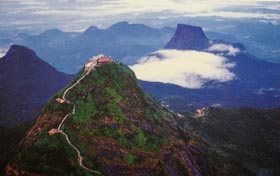
|
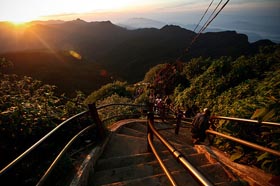
|
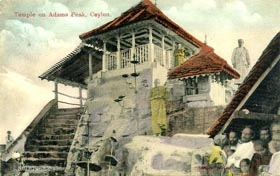
|
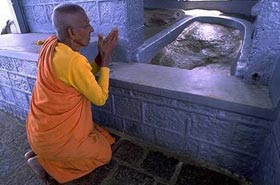
|
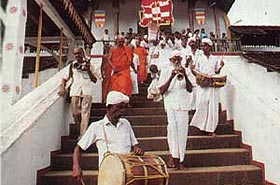
|
A Buddhist Pilgrim's Guide
by Ven. S. Dhammika
Mount Sinai was considered sacred at a much earlier date, Mt. Fuji surpasses it in beauty and height, and Mt. Kilash evokes a far greater sense of mystery. Nevertheless, no other mountain has been revered by so many people, from such a variety of religions, for so many centuries as Sri Pada has. In Sanskrit literature Sri Pada is called variously Mount Lanka, Ratnagiri (Mountain of Gems), Malayagiri or Mount Rohana. This last name, like its Arab and Persian equivalent, Al Rohoun, is derived from the name of the south western district of Sri Lanka where Sri Pada is situated. In several Tamil works it is known as Svargarohanam (The ascent to Heaven) while the Portuguese called it Pico de Adam and the English Adam's Peak. In the Mahavamsa, the great chronicle of Sri Lanka written in the 5th century CE, it is called Samantakuta (Samanta's Abode) while in modern Sinhalese it is often called Samanelakhanda (Saman's Mountain). Long before Buddhism came to Sri Lanka in about 246 BCE Sri Pada was revered as the abode the god called Samanta, or sometimes Saman or Sumana. This local mountain god was destined to go on to great things. The Theravada Buddhists of Sri Lanka later made Samanta the guardian of their land and their religion. With the rise of Mahayana Buddhism, a movement that began in south India from where it soon spread to the island, Samanta developed into Samantabhadra, one of the four principle bodhisattvas of Mahayana. Like his later manifestation, Samanta is usually depicted crowned and bejewelled, holding a lotus in his right hand and accompanied by a white elephant. At Weligama, an ancient port on Sri Lanka's south coast, there is a 12 ft high statue of Samantabhadra carved out of a huge moss-covered bolder. Pilgrims from India and northern Sri Lanka disembarking at Weligama were greeted by this bodhisattva's serene countenance as they set out on the long trek to Sri Pada. Today there is still a shrine to Samanta on the top of the mountain and another larger one near Ratnapura, some 19 kilometres from its foot. The name Sri Pada, while correctly referring only to the sacred (sri) footprint (pada) on its summit, is the most commonly used name for the mountain today.
Sri Pada soars
upwards to a height of 7360 feet from the very edge of the central
highlands and viewed from the southwest looks like a pinnacle on
a verdant castle wall. For about half the year it is oftenhidden
in cloud and the torrential rains that rush down its steep sides
during this time makes visiting the summit almost impossible. This
abundant precipitation feeds Sri Lanka's four main rivers which
all have their sources on the mountain's lower slopes. Over the
aeons these rains have also washed nearly a thousand feet of rock
and soil off Sri Pada and its surrounding peaks and the alluvial
deposits that extend from its foot towards the south and east are
one of the world's richest gem mining areas. Here are found rubies,
topaz, garnets, cats eye, aquamarine, Alexanderite and sapphires
ranging in colour from yellow to blue. Like the mountain itself
many legends are told about these gems. The Arabs believed they
were the crystallised tears Adam and Eve shed when they were expelled
from Paradise. The story the Chinese told about them was even more
beautiful. They said that when the Buddha visited Sri Lanka he found
the people poor and given to theft. So out of compassion and to
turn them to virtue he sprinkled the island with sweet dew which
crystallised into gems thus freeing the people from poverty by giving
them a commodity to trade with.
Sri Pada is surrounded by exceptionally dense forest, much of it
now making up the Peak Wilderness Sanctuary. This is not the lush
steamy cover one usually associates with the tropics but a cool
misty forest similar to that found in the lower reaches of the Himalayas.
Giant trees hang heavy with moss, rhododendrons put forth large
red blossoms and rare orchids like the Regal and the Chandraraja
grow in the dark moist loam. Although not actually growing on Śrī
Pada's slopes but in the forests further north and west, Sri Lanka's
famous spices have long been associated with the sacred mountain
too. The Arabs believed that these sweet spices grew from cuttings
and seeds which Adam bought with him from Paradise. A 14th century
Persian poem says that Allah created all Sri Lanka's spices and
flowers so that Adam's transition from Paradise to earth would be
less painful. In the past Sri Pada's forests were the home of numerous
elephants and the animal was so identified with the mountain that
it came to be seen as the mount of Samanta. In 1840 Major Skinner,
the famous engineer, actually reported finding elephant droppings
on the very top of Sri Pada early one morning. But with the establishment
of the coffee plantations in the 1850's these majestic creatures
were completely shot out although pilgrims still occasionally report
seeing Samanta's white elephant as they make the nocturnal journey
up the mountain. Of the two animals still associated with Sri Pada
the first is the butterfly. Sri Lanka is the home of numerous species
of glorious butterflies and once a year they form into long chains,
sometimes consisting of hundreds of the creatures, and fly through
the countryside. Popular legend says that they are all going to
Sri Pada to pay homage to the Buddha's footprint. The other animal
associated with the sacred mountain, the leech, is far less pleasant.
Ibn Batuta, the Moroccan traveller who visited Sri Lanka in 1344,
like many people before and since, was appalled by the tenacity
and ferocity of these leeches and mentioned that pilgrims would
carry lemons to keep them at bay. Today the jungle besides the paths
that lead up the mountain is cut back at the beginning of each the
pilgrim season thus lessening this problem. But rest for a moment
on a rock at the jungle's edge or walk into it to answer the call
of nature and hundreds of ravenous leeches will be waiting.
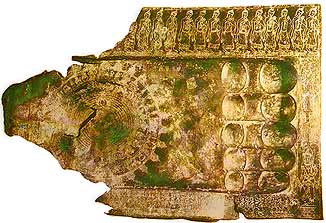 However
it not Sri Pada's geological particularities or natural beauty that
has made it so famous but something else altogether. On the summit
of the mountain is a boulder with a mysterious mark or indentation
on it resembling a human footprint. Since from perhaps as early
as the first century BCE the Sinhalese believed this mark to be
the footprint of the Buddha himself. According to the Mahavamsa,
the Buddha visited the island three times. During his last sojourn
he flew from Kelaniya to Sri Pada, leaving the impression of his
foot on the mountain top, and then left for Dighavapi. Whether the
Buddha's journey to Sri Lanka is true or not as a metaphor it is
very true. The Buddha's teaching has left its impression on every
aspect of Sri Lankan life as surely and as indelibly as if it had
been engraved in stone. Legend says that after King Valagambha was
driven from his throne in 104 BCE, he lived in a remote forest wilderness
for 14 years. On one occasion while stalking a deer he was led up
the mountain and discovered the sacred footprint. The gods revealed
to him that it had been made by the Buddha. The legend of the Buddha's
visits to Sri Lanka is not, it should be noted, confined to the
Theravada tradition. The Lankavatara Sutra, the seminal text of
the Ch'an and Zen schools of Buddhism, was supposedly taught by
the Buddha while residing on Malayagiri, "which shone like
a jewel lotus, immaculate and shining in splendour". The Chrakasamvara
Tantra mentions the Buddha flying to Lanka and leaving the impression
of his foot on a mountain which it doesn't name but which at least
one contemporary Tibetan scholar has mistakenly identified as Mount
Kailash in the western Himalayas. While Buddhists knew that this
mysterious footprint had been made by the Buddha in succeeding centuries
other faiths, Islam, Hinduism and Christianity were to lay claim
to it also. A 15th century Chinese work says the footprint was made
by Pwan-ko, the primordial man of Chinese mythology. South Indian
Hindus believed it had been made by Shiva. Moses of Chorene never
saw the footprint himself but proclaimed that it had been made by
the Devil. The Portuguese could never quite make up their minds
whether it had been made by Adam, St Thomas or the eunuch of Candace,
Queen of Sheba, although they never doubted its veracity. Ibn Batuta
mentioned that sometime before his visit the Chinese had come and
cut the mark of the big toe out of the rock and enshrined in a temple
in China "where it is visited by people from the farthest parts
of the land". An early Thai king sent monks to Sri Lanka to
make an impression of the footprint and then had copies made in
bronze and distributed all around his kingdom. (see above: copy
of the Buddha's Footprint from Sri Pada, Sukhodaya style, 14th century).
The famous statue of the Buddha from Sukhodaya with its beautiful
flowing lines, does not depict him walking, as is commonly supposed,
but him making the mark of his foot on Sri Pada.
However
it not Sri Pada's geological particularities or natural beauty that
has made it so famous but something else altogether. On the summit
of the mountain is a boulder with a mysterious mark or indentation
on it resembling a human footprint. Since from perhaps as early
as the first century BCE the Sinhalese believed this mark to be
the footprint of the Buddha himself. According to the Mahavamsa,
the Buddha visited the island three times. During his last sojourn
he flew from Kelaniya to Sri Pada, leaving the impression of his
foot on the mountain top, and then left for Dighavapi. Whether the
Buddha's journey to Sri Lanka is true or not as a metaphor it is
very true. The Buddha's teaching has left its impression on every
aspect of Sri Lankan life as surely and as indelibly as if it had
been engraved in stone. Legend says that after King Valagambha was
driven from his throne in 104 BCE, he lived in a remote forest wilderness
for 14 years. On one occasion while stalking a deer he was led up
the mountain and discovered the sacred footprint. The gods revealed
to him that it had been made by the Buddha. The legend of the Buddha's
visits to Sri Lanka is not, it should be noted, confined to the
Theravada tradition. The Lankavatara Sutra, the seminal text of
the Ch'an and Zen schools of Buddhism, was supposedly taught by
the Buddha while residing on Malayagiri, "which shone like
a jewel lotus, immaculate and shining in splendour". The Chrakasamvara
Tantra mentions the Buddha flying to Lanka and leaving the impression
of his foot on a mountain which it doesn't name but which at least
one contemporary Tibetan scholar has mistakenly identified as Mount
Kailash in the western Himalayas. While Buddhists knew that this
mysterious footprint had been made by the Buddha in succeeding centuries
other faiths, Islam, Hinduism and Christianity were to lay claim
to it also. A 15th century Chinese work says the footprint was made
by Pwan-ko, the primordial man of Chinese mythology. South Indian
Hindus believed it had been made by Shiva. Moses of Chorene never
saw the footprint himself but proclaimed that it had been made by
the Devil. The Portuguese could never quite make up their minds
whether it had been made by Adam, St Thomas or the eunuch of Candace,
Queen of Sheba, although they never doubted its veracity. Ibn Batuta
mentioned that sometime before his visit the Chinese had come and
cut the mark of the big toe out of the rock and enshrined in a temple
in China "where it is visited by people from the farthest parts
of the land". An early Thai king sent monks to Sri Lanka to
make an impression of the footprint and then had copies made in
bronze and distributed all around his kingdom. (see above: copy
of the Buddha's Footprint from Sri Pada, Sukhodaya style, 14th century).
The famous statue of the Buddha from Sukhodaya with its beautiful
flowing lines, does not depict him walking, as is commonly supposed,
but him making the mark of his foot on Sri Pada.
With shipping lanes through south east Asia becoming more reliable after the 5th century CE this became the favoured route for Indian and Chinese Buddhist monks and nuns going to each others country. Such missionaries and pilgrims often stopped off in Sri Lanka to visit the island's many shrines. The famous Chinese pilgrim Fa Hien stayed in Sri Lanka in 411-12 and mentions Sri Pada in his travelogue, although it is not clear whether he actually went there. The Indian monk Punyopaya "climbed Mount Lanka" while on his way to China in 655. At about the same time the Kashmiri monk Vajrabodhi visited Śrī Lanka and after a six month stay in Anuradapura, set out for Śrī Pada. "When at last he reached the foot of the mountain, he found the country wild, inhabited by wild beasts and extraordinary rich in precious stones." Like many pilgrims Vajrabodhi was moved by the spectacular view from the mountain's top. "After long waiting, he was able to climb to the summit and contemplate the impression of the Buddha's foot. From the top he saw to the north west the kingdom of Ceylon and on the other side the ocean". In 1411 the grand fleet of the emperor of China commanded by the eunuch admiral Ch'ing-ho, arrived in Galle harbour to offer gifts to the sacred footprint on the emperor behalf. According to the inscription Ch'ing-ho later set up to record his mission, the gifts included " 1000 pieces of gold, 5000 pieces of silver, 50 rolls of embroided multicolored silk, 4 pairs of jewelled banners, 5 antique incense burners, 6 pairs of gold lotuses, 2,5000 catties of perfumed oil" and numerous other things. In 1423 a large group of Thai and Cambodian monks who were in Sri Lanka studying and collecting texts climbed the sacred mountain before returning to their homelands. The leader of this group made a copy of the footprint and took back to Thailand with him. At the beginning of the 16th century the Portuguese conquered Sri Lanka's maritime provinces and forbade Buddhists living under their jurisdiction and those coming from overseas from going to Sri Pada. By way of contrast, the king of Kandy in whose realm the mountain was situated, allowed Christians to enter his territory to make the pilgrimage. When the Dutch took over the maritime provinces in 1656 they proved to be less bigoted than the Portuguese but fear that pilgrims might act as spies for the king of Kandy led them, if not to ban, then at least to discourage visits by levying a heavy tax on pilgrims .For nearly two centuries Sinhalese Buddhists living in the low country could see the sacred mountain, worship it from afar but not go there.
The first western
reference to Sri Pada is in Ptolemy's Geography where it is called
Valspada and the first specifically Christian mention of it is found
in Valentinus' Pistis Sophia. In this 2nd century Gnostic work Jesus
is represented as saying to the Virgin Mary that he had appointed
the angel Kalapataras as guardian over the mark "impressed
by the foot of Adam and placed him in charge of the books of Adam
written by Enoch in Paradise". There are only occasional Christian
references to the mountain in the proceeding centuries. Macro Polo
did not visit Sri Lanka specifically to make a pilgrimage to Śrī
Pada; he was on a diplomatic mission for Kublai Khan at the time,
although he was the earliest European to leave a reasonably accurate
account of it. "In this island there is a very high mountain,
so rocky and precipitous that the ascent to the top is impracticable,
as it is said, excepting by the assistance of iron chains employed
for the purpose. By means of these some persons attain the summit,
where the tomb of Adam, our first parent, is reported to be found.
Such is the account given by the Saracens. But the idolaters assert
that it contains the body of Sogomon Barchan (Sakyamuni Buddha),
the founder of their religious system, and whom they revere as a
holy personage". Some 35 years after Marco Polo, Friar Odoric
of Postenau returning to Europe from China broke his journey in
Sri Lanka to make a pilgrimage to the sacred mountain. While climbing
up he was shown the famous Fountains of Paradise, said to have been
formed by the tears of Adam and Eve. However, the good friar was
not impressed. The fountains looked to him like ordinary mountain
springs and although the water was crystal clear, it was full of
leeches. In about 1348 another European monk, the legate of Pope
Clement V1 to China, Goivanni de Marignolli, climbed Sri Pada. He
wrote of it, "It is a pinnacle of surpassing height, which,
on account of the clouds, could rarely be seen; but it lighted up
one morning just before the sun rose, so that they beheld it like
the brightest flame. It was the highest mountain on the face of
the earth and some thought that Paradise existed there". Coming
from his cold gloomy medieval cloister to the eternal spring of
Sri Lanka, de Marignolli had no difficulty believing that Paradise
was nearby but he was not one to swallow everything he was told.
He estimated that Paradise was in fact 40 miles further north of
the mountain. The climate of religious tolerance in Sri Lanka was
also very different to what de Marignolli was used to. "The
Buddhist monks on the mountain and elsewhere are very holy, though
they have not the Faith... They welcomed me into their monasteries
and treated me as one of their own".
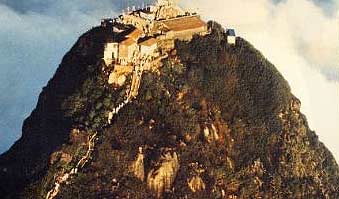 However,
by the late middle ages European interest in Sri Pada had nearly
faded away. When Fra Mauro drew his celebrated mappa mundi in Venice
in 1459 on it he included a picture of Sri Pada and its sacred footprint,
not for its religious but for its geographical significance. The
situation had not changed though amongst the Christians of South
India. Supposedly evangelised by St Thomas in about 59 CE but more
probably the descendants of Nestorian Christian merchants originally
from Persia, these people had been coming and indeed continued to
come to the sacred mountain for centuries. After the Portuguese
conquest of Sri Lanka, Sinhalese forcibly converted to Catholicism
began joining these Indians on the yearly pilgrimage. In 1803 Robert
Percival was able to write, "The Roman Catholic priests, with
their usual industry, have taken advantage of the current superstition
to forward the propagation of their own tenets; and a chapel which
has been erected on the mountain is yearly frequented by vast numbers
of black Christians of the Portuguese and Malabar race". In
1684 Daniel Pathey, a German solider in the Dutch East India Company,
became the first European since medieval times to climb Sri Pada
and give a firsthand description of it. Since then there have been
numerous other accounts of the mountain. One that deserves a mention
because of the way its no-nonsense rationalism contrasts with the
piety and sense of wonder of earlier accounts, is that written in
1819 by the first Englishman to make the ascent, Dr Henry Marshall.
" The area of the summit of the peak is 72 feet long and 54
broad, and is enclosed by a parapet wall five feet high... in the
middle of this area is a large rock of Kabooe or iron-stone upon
which is the mark of Adam's left foot, called Sri Pada by the Singhalese;
but it requires a great deal of help from imagination to trace it
out. This sacred footprint is covered over with a small building
formed of the most durable wood 12 feet long, 9 broad and 4 to the
tiles with which it is surmounted. Upon the inside it is enclosed
by a frame of copper fitted to its shape, and ornamented with numerous
jewels set in four rows, but not of the best or most precious gems
the island has been known to produce, for to me they looked very
like glass. We were not, I regret to say ,provided with an 'Union
Jack' but we fired three volleys, to the great astonishment of the
Buddhists as a memorial to them that a British armed party had reached
the summit... Sound lungs and hard feet are indispensable to the
performance of such a trip, for in many places we had climbed barefoot
over the iron-stone. As to palankins, they are quite out of the
question. There may be some risk in ascending Adam's Peak in heavy
rain but surely not in fine weather".
However,
by the late middle ages European interest in Sri Pada had nearly
faded away. When Fra Mauro drew his celebrated mappa mundi in Venice
in 1459 on it he included a picture of Sri Pada and its sacred footprint,
not for its religious but for its geographical significance. The
situation had not changed though amongst the Christians of South
India. Supposedly evangelised by St Thomas in about 59 CE but more
probably the descendants of Nestorian Christian merchants originally
from Persia, these people had been coming and indeed continued to
come to the sacred mountain for centuries. After the Portuguese
conquest of Sri Lanka, Sinhalese forcibly converted to Catholicism
began joining these Indians on the yearly pilgrimage. In 1803 Robert
Percival was able to write, "The Roman Catholic priests, with
their usual industry, have taken advantage of the current superstition
to forward the propagation of their own tenets; and a chapel which
has been erected on the mountain is yearly frequented by vast numbers
of black Christians of the Portuguese and Malabar race". In
1684 Daniel Pathey, a German solider in the Dutch East India Company,
became the first European since medieval times to climb Sri Pada
and give a firsthand description of it. Since then there have been
numerous other accounts of the mountain. One that deserves a mention
because of the way its no-nonsense rationalism contrasts with the
piety and sense of wonder of earlier accounts, is that written in
1819 by the first Englishman to make the ascent, Dr Henry Marshall.
" The area of the summit of the peak is 72 feet long and 54
broad, and is enclosed by a parapet wall five feet high... in the
middle of this area is a large rock of Kabooe or iron-stone upon
which is the mark of Adam's left foot, called Sri Pada by the Singhalese;
but it requires a great deal of help from imagination to trace it
out. This sacred footprint is covered over with a small building
formed of the most durable wood 12 feet long, 9 broad and 4 to the
tiles with which it is surmounted. Upon the inside it is enclosed
by a frame of copper fitted to its shape, and ornamented with numerous
jewels set in four rows, but not of the best or most precious gems
the island has been known to produce, for to me they looked very
like glass. We were not, I regret to say ,provided with an 'Union
Jack' but we fired three volleys, to the great astonishment of the
Buddhists as a memorial to them that a British armed party had reached
the summit... Sound lungs and hard feet are indispensable to the
performance of such a trip, for in many places we had climbed barefoot
over the iron-stone. As to palankins, they are quite out of the
question. There may be some risk in ascending Adam's Peak in heavy
rain but surely not in fine weather".
The third great world religion to hold Sri Pada sacred is Islam. All Muslims accept that after Adam was cast out of Paradise he left the mark of his foot on the top of a mountain. There was however a difference of opinion in ancient Islam about exactly where Paradise was. Some said it was on earth while others contended that it was in heaven. It was this second school's opinion that eventually prevailed. Paradise was in heaven and when Adam was expelled his foot first touched the earth at its loftiest point which was Sri Pada. Al Tabari in his great history of the world, asserts that the mountain was so high that "when Adam was cast upon it, his feet touched it while his head was in heaven and he heard the prayer and praise-giving of the angels". This apparently annoyed the angels and "they eventually complained to Allah in their various prayers and Allah therefore, lowered Adam (completely) down to earth". When Ibn Batuta was in Shiraz in Persia he was shown the grave of Shaikh Abu Abdullah Khafif, supposedly the first Muslin to go to Sri Pada in the year 929 CE. "Previously the infidels (Buddhists) prevented the Muslims from visiting it, vexed them, and neither dinned with them nor had any dealings with them." However, the Shaikh, who had lived in Chilaw for some years and had gained a reputation amongst the Sinhalese for holiness was finally allowed to join a group of pilgrims going to the mountain. At one point in the journey the party found itself in a jungle wilderness without any food. To save themselves they killed a baby elephant and eat it, though the Shaikhs advised against this and refused to partake of the meat. That night as the party slept a herd of elephants appeared, sniffed each person and crushed to death all those on whom they smelt the flesh of their kin. The chief elephant then put the Shaikh on his back and took him to the nearest village. "From that time the infidels began to honour the Muslims and up to this day they revere the Shaikh and call him the Great Shaikh". However, despite what Ibn Batuta was told the evidence shows that Muslims were making the pilgrimage to Sri Pada before the time of Abu Abdullah Khafif . Sulaiman, an Arab trader is known to have gone to Sri Pada in 850 and Al Qazwini who died in 1282 quotes a hadith of the Prophet which says, "The best spot where the camel knelt down is Mecca, thereafter this mosque of mine (i.e. Medina) and Al Aqsa Mosque (in Jerusalem) and the island of Sarandib where our father Adam had descended". If this hadith is authentic it would show that Muslim reverence of Sri Pada began with the Prophet Mohammed himself. Since Iran's Islamic Revolution in 1979 Sri Lanka's Muslims have become more orthodox and more determined to stand apart from their fellow countrymen and consequently few now visit Sri Pada. But old traditions die hard. Recently an acquaintance of mine while half way up the mountain, encountered two men in distinct Middle Eastern attire. He talked with them and was told that they were both from Oman and while on business in Colombo had decided to go to Sri Pada. One of the Omanis also said that his grandfather had made the pilgrimage in the 1930's.
Hindu reverence
for Sri Pada and its sacred footprint was mainly confined to South
India and even there does not seem to have been very strong or widespread.
Ibn Batuta was accompanied on his pilgrimage by four Hindu yogis
who went yearly, four Brahmins and ten companions of the king of
Jaffna, indicating that at least in the 14th century it was popular
with Hindus living in the northern part of Sri Lanka. Hindus actually
controlled the shrines on the sacred mountain at one time. In 1581
the crown prince of Kandy murdered his father and proclaimed himself
King Rajasinghe I. When he asked the Buddhist monks how he could
expunge the evil kamma he had made they, to their credit, told him
that like everyone else he would have to take responsibility for
his own actions. This was not what he wanted to hear. The brahmin
priests on the other hand were only to willing to perform a puja
to help the king ease his guilty conscience and so he converted
to Hinduism. The Buddhist monks were driven off Sri Pada, it was
handed to the brahmin priests and they administered it for the next
160 years.
How did Sri Pada and its mysterious footprint become so widely known
from such an early period? Sri Lanka is situated right on the main
sea route between east and west, the so called Silk Road of the
Sea. From at least the 3d century BCE Arab ships were sailing to
the south and east coasts of India and four hundred years later
Roman ships were joining them. From perhaps the 4th or 5th CE century
Chinese and Javanese were coming to India from the other direction.
When all these mariners sailed passed Sri Lanka or landed on its
shores they could see the sacred mountain quite clearly. The Mahabharata
describes Sri Pada from the sea as "an exceedingly wondrous
sight, which is endowed with supreme splendour". Idris, court
geographer to King Roger of Sicily, writing in 1154 says "...it
is so elevated that it can be seen several journeys out to sea".
Ibn Batuta wrote that he saw the mountain "rising into the
heavens like a pillar of smoke" nine days out. While this is
certainly an exaggeration it is true that Sri Pada can be seen rising
above the horizon nearly eighty miles before the coastline comes
into view. For those sailing across the Indian Ocean from the barren
coasts of Ethiopia or Arabia the mountains blue-green spire must
have been a welcome sign that they were about to arrive in a safe
harbour. For centuries navigators used Sri Pada to get a bearing.
It was these men, sailors, merchants and adventures who took the
legends and stories about Sri Pada to the furthermost corners of
the known world.
Sri Pada's religious associations, its height and its great natural beauty have long made it a favourite with writers and poets and its glories are celebrated in the literature of a dozen languages. The most famous such work is the Sumantakutavannana, a Pali poem composed in the 13th cent by Veheda Thera. Some twenty of the poems' verses are devoted to praising the mountains silvan beauty. The Salalihini Sandesa (15th cent) is a similar work but in Sinhalese while the Suvul Sandesa (16th cent) is a poem beseeching Samanta to protect Sri Lanka and her king. Sri Pada often figures in the Sanskrit literature of India. The Anargharaghava, a 9th century retelling of the Ramayana, has Rama in his magic chariot flying back to Ayudha pointing towards the south and saying to Sita, "There appears to view the Island of Simhala, a blue lotus arising from the ocean, made even more beautiful by the filaments of the Mount of Jewels". There is a delightful verse in the Sukitmuktavali where gems from the foot of the mountain, about to be carried away to be made into king's crowns and queen's diadems bid a cheerful farewell to the mountain. In the 9th century play the Balaramayana, the king of Sri Lanka is called "the Lord of the Mountain of Jewels, Rohana". The Rajataragani, written in Kashmir in the 11th century, includes a tale about the mythological King Meghavahana who came to Sri Lanka to receive homage from Vibhisana the lord of the Raksasas and then climbed Sri Pada. In other works Sri Pada is used as an exotic destination or a colourful backdrop. In The Thousand and One Nights, written in Persia between the 9th and 13th centuries, it is one of the strange places that Sinbad visited. "I made, by way of devotion, a pilgrimage to the place where Adam was confined after his banishment from Paradise, and had curiosity to go to the top of the mountain". In the Tamil epic Manimekela one character describes her pilgrimage to Sri Lanka "where stands the lofty Mount Samanta, on whose summit are the footprints of the Buddha, that ship of righteousness for traversing the ocean of birth and death". The sacred mountain also gets a mention in the old Malay version of the Ramayana, in Buzurg Ibn Shahriyar's Book of the Wonders of India and even in the 14th century apocryphal Voyages and Travels of Sir John Manderville. Sri Pada's most recent appearance in literature is in Arthur C Clarks science fiction novel Fountains of Paradise.
INFORMATION
WHEN TO GO
The pilgrims season to Sri Pada traditionally starts on the full moon of December and ends on the full moon of April . It takes a while for the crowds to build up but by the second half of the season they can be very large so it is best to go earlier. Weekends and particularly full moon days are always crowded and should be avoided. Most people make the climb at night so they can arrive in time for the sunrise. Alternatively, you can climb up during the day, stay overnight and go down the next morning. This way you can avoid the crowds, climb at a leisurely pace, have plenty of time to enjoy the view, see the sunset and get the best place to observe the sunrise in the morning. Accommodation on the summit is basic and you would have to bring your own food and perhaps a blanket or sleeping bag. However, whenever you decide to go, check the weather report before setting out. Rain can make for a miserable trip and it is more likely that cloud or mist will obscure the view.
HOW TO GET THERE
In ancient times the only way to approach Sri Pada was from Ratnapura, the City of Gems. When Sinhalese civilisation moved to the central highlands after the 13th century and the forests began to be cleared, two other paths, one from Uva and another from Kehelgamuva, also came into use. These two paths ceased to be used at least a hundred years ago and indeed they can hardly be traced today. After the British began building roads through the highlands in the middle of the 19th century the Hatton path became and remains the most popular pilgrims route to the mountain. There are several ways to get to Hatton. You can take a bus from the Colombo Bus Stand. Alternatively you can take a bus from Kandy's Goods Shed Bus Dept which is situated just past the Post Office. Once at Hatton take one of the numerous private buses to the foot of the mountain, a distance of about 33 kilometres. Hatton is also on the main Colombo-Kandy-Nuwara Eliya railway line so it is possible to get there by train. The more adventurous traveller might consider taking the Hatton path up and the Ratnapura path down. This second path is thickly forested for its entire length, crosses numerous streams and is definitely only for those used to trekking. There are few food stalls on the way so it can be a good idea to bring water and something to eat. It is at least a five hour trek to the first village, Sripadagama from where regular buses go to Ratnapura.
WHAT TO BRING
Whether making the ascent by day or night it can be an arduous climb, so bring only what you are likely to need. There are food and drink stalls all the way up the Hatton path but prices are considerably higher than normal so you might like to bring your own snacks and water. You are likely to be warm during the climb itself but you can get very cold while waiting for the sunrise at the summit, so bring warm cloths. If the weather is uncertain an umbrella or rain coat will be useful. A pair of binoculars if you have them will also be most useful.
WHAT TO SEE
The Ascent
From the bus stop to the summit the Hatton path is about 3 kilometres
long and if there are no delays, takes about four hours to climb.
For some way both sides of the path are lined with stalls and shops
selling all manner of things. Among the junk for sale you will notice
small booklets of poems, songs and verses that have traditionally
been sung by pilgrims making the ascent. The ascent proper starts
at the great Makhura Gateway some way from the bus stop. Beyond
this point you will notice that much of the path consists of cement
or rough stones stairs and that the whole way is illuminated with
electric lights. The story behind the electrification of the path
is an interesting one.
Since the inauguration
of the Norton Bridge Hydro Scheme in 1924 the project had been plagued
by one problem after another, delays, strikes and several bad accidents.
When the contractors eventually requested to pull out it looked
as if the project would never be completed. Finally on the 2nd November
1947 Sir John Kotelawala, then minister of works and later to become
prime minister, made a vow to Samanta that if the project was finished
soon and without further mishaps, he would electrify the paths up
the mountain. The workers' morale shot up, accidents ceased, the
scheme was successfully completed and Sir John was able to fulfil
his vow.
Before the light
were installed pilgrims had to provide their own illumination, candles
or hurricane lamps and before that "tubes filled with a resinous
substance... giving out a strong flaming blaze when lighted".
William Skeen describe the dramatic impression created by these
burning torches as he looked down from the summit during his visit
to Sri Pada in the 1860's. "The heavens above were clear, the
stars were shining bright, and the glorious full-orbed moon was
scarcely passed its zenith. From the Peak, ablaze with light to
Heramitipana station similarly lighted up, the whole of the pilgrims
path was filled as it were, with a living chain of fire, connecting
the two points together and formed by the torches of the multitudes
going to and fro".
As you proceed you will pass numerous danasalas offering shelter, medical assistance and sometimes food and water to pilgrims. The tradition of offering hospitality to pilgrims is an ancient one in Sri Lanka. The Mahavamsa records this concerning King Vijayabahu (1058-1114). "Saying ,'Let no one endure hardship who goeth along the difficult pathways to worship the Footprint of the Chief of Sages on Samantakuta Mountain', he caused the village of Gilimalaya which abounds in rice fields and other lands, to be granted to supply pilgrims with food. And at the Kadatigama road and at the Uva road he built rest houses". Pilgrims going to Sri Pada traditionally greet each other by saying 'Karunava' meaning 'Compassion to you'. If you say this to the people you meet you are sure to get a warm smile and a similar greeting in return.
The Sama Chatiya
After a while you will come to the Sama Chatiya, the World Peace Pagoda. This stupa was built by the famous Japanese Buddhist monk Ven Nichi Fuji in 1976 and is maintained by several Japanese monks. At night there is little to see but during the day the brilliant white stupa stands out dramatically against the vast grey cliff behind it.
The Bhagava Cave
About 150 feet from the summit, just next to the last tea shop, is the Bhagava Cave. To get there climb on to the retaining wall and just walk into the undergrowth for a few yards. For centuries this cave was the only refuge for pilgrims caught on the mountain at night and for those seeking shelter from storms. Acetic monks used to spend the nine months of the off season up here, completely isolated from the world below, living off wild fruit, herbs and moss. There are two inscriptions on the wall of the Bhagava Cave. The first was written by King Nissankamalla (1187-1196) when he climbed Sri Pada during one of the many tours he made of his kingdom. This inscription records the improvements he made to the path up the mountain and the generous gifts he offered to its shrines. To the left of the inscription is the figure of a man in the gesture of reverence, probably a portrait of the king. Further to the left is yet another inscription. Written in Arabic in the 13th century it reads, "Mohammed, may Allah bless him...the father of Mankind". There is another cave on the slopes of Sri Pada, the Divaguha, where the Buddha is said to have rested. It is referred to in many ancient sources but to this day it has not been located.
The Sacred Footprint
There is little to see on the top of Sri Pada, a few buildings, the belfry with the bell that people traditionally ring once for each time they have made the pilgrimage, the shrine to Samanta and right next to it, the shrine over the sacred footprint. It is to worship at this last place that people throughout the centuries have risked hardship and danger to come to Sri Pada. Nearly as much has been written about the sacred footprint as has been about the mountain itself. According to Giovani de Marigolli, "The size, I mean the length thereof, is two and a half of our palms, about half a Prague ell. And I was not the only one to measure it , for so did another pilgrim, a Saracen from Spain". Robert Knox, an Englishman who lived in Sri Lanka in the 17th century, wrote that it was "about two feet long". John Ribeyeo in his account of Sri Lanka presented to the king of Portugal in 1687 claimed that the footprint "could not be more perfect had it been done in wax" and in 1859 James Emerson Tennent described it as "a natural hollow artificially enlarged, exhibiting the rude outline of a foot about five foot long". Obviously peoples perception of the sacred footprint differ according to their expectations and their faith, or lack thereof. Look carefully and see what you think of it. Remember also that the footprint is an object of great religious significance to Buddhists so an attitude of quiet respect while near it and indeed throughout your stay on the summit is appropriate.
The View and The Sunrise
Sri Pada is not actually very high but its steep sides and the many
lower mountains surrounding it give the impression of exceptional
loftiness. It is sometimes possible to watch from above as clouds
silently drift past. James Emerson Tennent's description says it
all. "The panorama from the summit of Adam's Peak is perhaps
the grandest in the world, as no other mountain, although surpassing
it in altitude , presents the same unobstructed view over land and
sea. Around it, to the north and east, the traveller looks down
on the zone of lofty hills that encircle the Kandyan kingdom, whilst
to the westward the eye is carried far over undulating plains, threaded
by rivers like cords of silver, till in the purple distance the
glitter of the sunbeams on the sea mark the line of the Indian Ocean"
Every morning a series of intriguing phenomena can be observed from
the summit of Sri Pada. Just before sunrise everyone will assemble
on the eastern side of the summit waiting for the sun. When it appears
it seems to leap over the horizon rather than rise gradually. At
this moment the more pious people will shout 'Sadhu!' an exclamation
meaning 'It is good'. The Sinhalese say that the sun is paying homage
to the Buddha's footprint. Then everyone will move to the western
side of the mountain. Join them and you will see the perfectly triangular
shadow of the mountain laying over the landscape. Sometimes if there
is a light mist the shadow will appear to stand upright. Within
moments, as the sun climbs higher, the shadow will move rapidly
towards the base of the mountain and finally disappear. This phenomena
is supposed to occur in only one other place in the world, somewhere
in Arizona.
The Ancient Chains
Go to the stairs leading down to Ratnapura and descend about a hundred
feet. You will notice that soon the stairs become very steep. Everywhere
else the hand rails are helpful, here they are absolutely necessary.
On the right you will notice large chains riveted into the rock.
In the thousand or so years that the Ratnapura path was the only
way up the mountain these chains assisted the final ascent and they
are mentioned in most ancient accounts of Sri Pada. The Muslims
believed they were put here by Alexander the Great. The Zaffer Namah
Sekanderi, a 15th century Persian poem celebrating the exploits
of Alexander says "he fixed thereto chains with rings and rivets
made of iron and brass, the remains of which exist even today, so
that travellers, by their assistance, are enabled to climb the mountain
and obtain glory by finding the sepulchre of Adam". In actual
fact they were probably first put here by an early Sinhalese king
and replaced when needed over the centuries. In 1815 Major Forbes
witnessed a tragic but at that time not uncommon accident at this
very place. "Several natives were blown over the precipice,
and yet continued clinging to one of the chains during a heavy gust
of wind; but in such a situation, no assistance could be rendered,
and they all perished".
References
C. W. Nicholas,
Historical Topography Of Ancient and Medieval Ceylon, Colombo, 1963.
K. A. Nilakanta Sastri, Foreign Notices of South India, Madras,
1939.
W. Skeen, Adam's Peak, Colombo, 1870.
H. Yule, Cathay and the Way Thither, Vols I-IV, 1913-16.
Courtesy: www.buddhanet.net
See also: Sri Pada section of A Buddhist Pilgrim's Guide to Sri Lanka by Ven. S. Dhammika